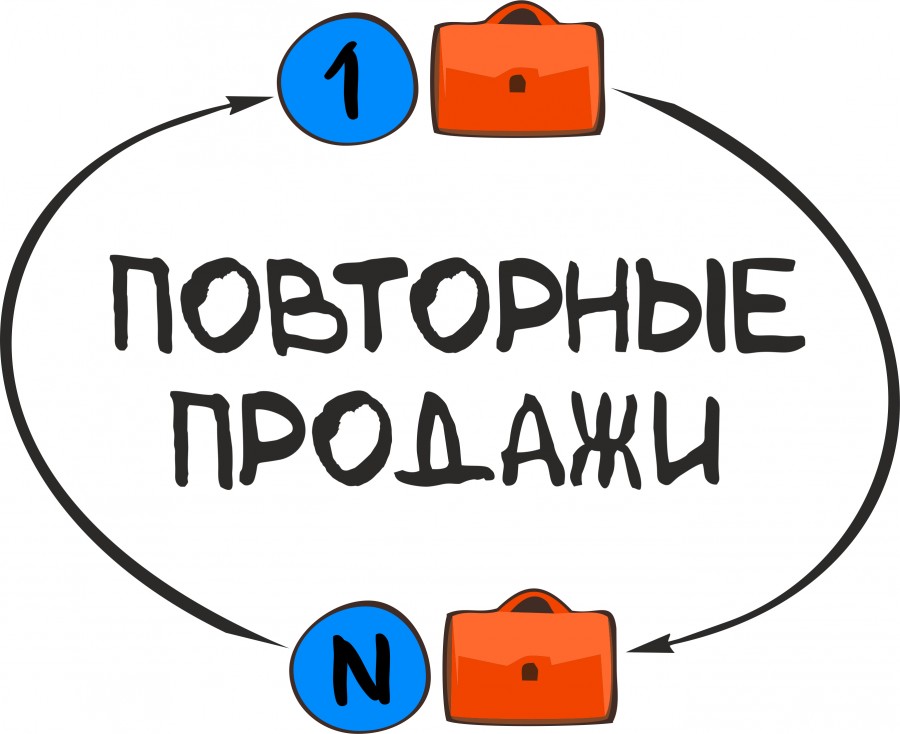- Make regular purchases.
- Acquire a wide range of your products and services.
- Do not respond to competitors' offers.
- Recommend you to their friends and acquaintances.
To build a stable customer base, organizations need to: firstly, use marketing and sales tools that attract new customers; second, engage and retain customers for repeat purchases.
Unfortunately, most of the customers who made their first purchase stop contacting the same company for various reasons. Often, this happens because organizations do not "look after" customers: they do not call, do not provide discounts, do not offer loyalty programs. The company is losing potential customers and, of course, part of its income. The solution to this problem is solved through repeat sales.
Repeat sales are sales across your customer base to customers who have purchased your product or service at least once. Repeat sales are driven by 'engagement' and 'retention' business processes.
In the “engagement” business process, the company tries to encourage customers who have purchased once to make a second purchase from them. This is an important step towards turning a new client into a regular one. This strategy uses loyalty programs.
In the retention business process, the company concentrates on interacting with regular customers. In this case, customers get acquainted with the entire line of products and services of the company, use loyalty programs, track the appearance of new products, etc. A regular customer is valuable because much fewer resources are spent on keeping him than on attracting new customers.

For successful business development and getting more profit, it is necessary to attract and retain customers by implementing repeat sales, it is not enough to make single sales when working with new customers only.
Unfortunately, most companies do not engage and retain customers, and firms lose 20-40% of their customers every year. Interestingly, customer churn is probably the least recognized and most misunderstood dynamic in any organization. Many CEOs believe that customer churn is inevitable and do not try to manage it. The lack of a repeat sales strategy is detrimental to the company because the companies are not getting the revenue they want.
Annual percentage of loyal customers by industry (churn of loyal customers)

In almost every industry, it is possible to re-sell. Considering the annual percentage of customer losses, we understand how much potential revenue companies are losing.
However, it's not just the loss of money that drives the focus on customer retention. Every time a client abandons a company, you also lose your reputation and a valuable source of information about your business. If a satisfied customer is a good advertisement, then a lost customer is often a bad advertisement. Each of these lost clients is a potential bad news messenger.
People share their stories of dissatisfaction with others, which in turn damages the company's business reputation. However, if you reach out to lost customers and determine the reason for their departure, you can learn important information about your business practices. Were the employees of the company rude to clients? What steps can you take to avoid losing other customers?
A loyal customer is a valuable asset and you shouldn't give it up without a fight!
How much is one lost customer really worth

Possible damage to the business in the future - the loss of 17 potential customers who could turn to you to purchase a product and become your regular customers.
Let's take a closer look at why repeat sales are critical to a company's success:
1. Growth in the number of sales
It is necessary to realize that the number of new clients is limited. Providing stable revenue growth is problematic if you only work with new customers. Repeated sales ensure the retention of new customers and increase the share of revenue from working with regular customers. Thus, the number of sales increases.
2. Reducing marketing costs
Depending on the business sector, the process of attracting new customers is 3-7 times more expensive than retaining regular customers. In the case of regular customers, word of mouth works: satisfied customers recommend your products or services to friends and acquaintances, thereby reducing your advertising costs.
3. Business sustainability
The overall growth of the customer base increases revenue and makes the company more stable. Revenue from regular customers is a stable source of income for a business. Failure to acquire new customers has less impact on a company's ability to be profitable and fund development plans.
4. Increasing business profitability
The cost of acquiring new customers is higher than the cost of retaining repeat customers. Hence, business profitability increases with a larger loyal customer base.
5. Protection from price competition
Regular customers are loyal to your company, they have a high level of trust. The client is ready to purchase your product or service at a price without comparing it with the prices of other companies, as he is familiar with your level of work and quality of service.
Thus, we can conclude: with lower marketing costs and higher profitability of the business, repeat sales contribute to the sustainable development of the company, allow you to increase your customer base, and, consequently, revenue.